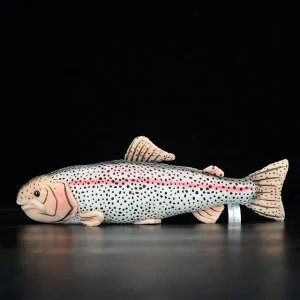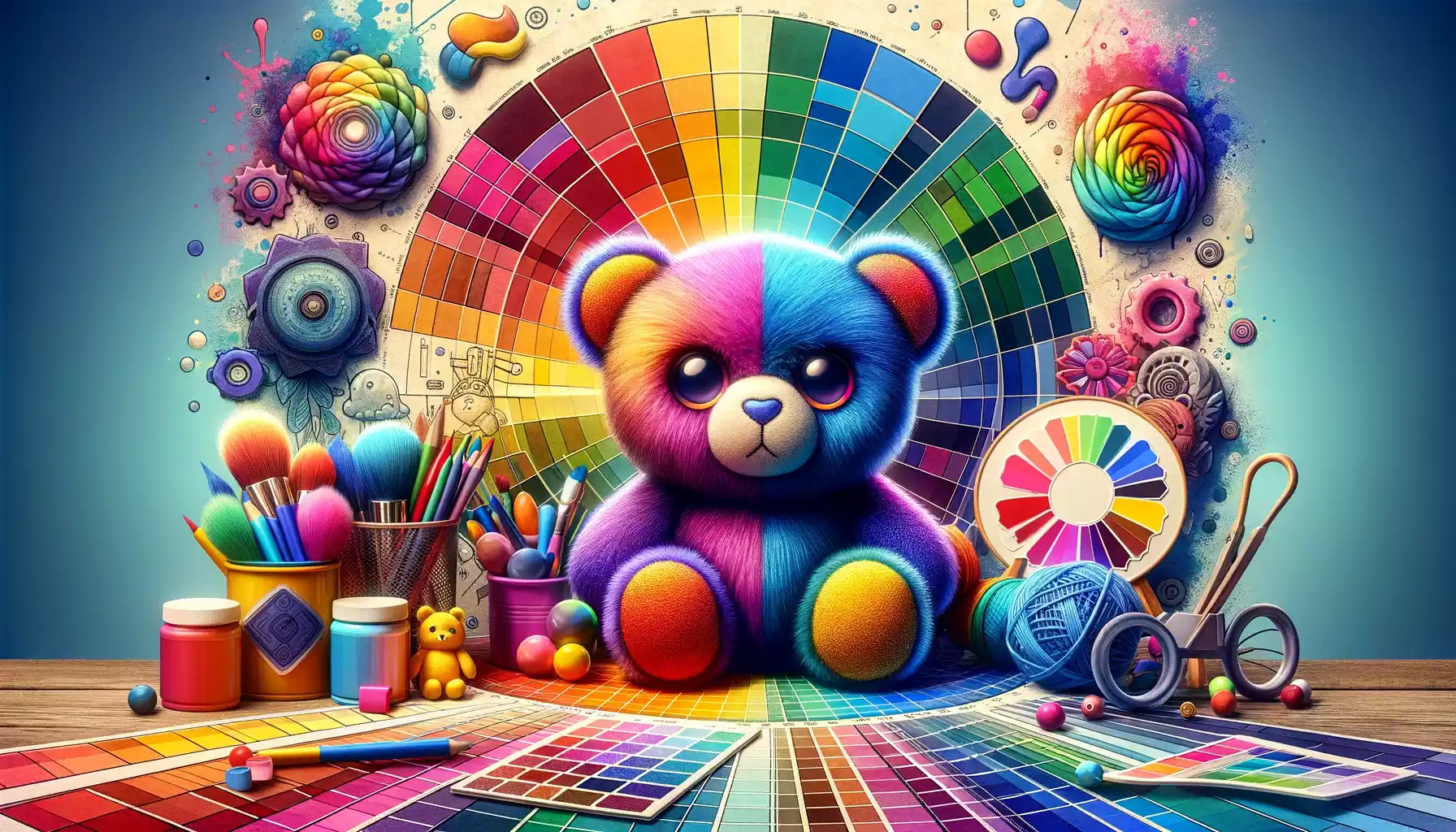The selection of colors for plush toy design significantly impacts children’s perceptions and interactions with the toy, affecting their moods and igniting their imagination.
Designers must comprehend the psychology behind color choice to evoke specific emotions in children, considering the colors themselves and their combined effect and cultural significance.
Exploring the influence of color in plush toy design reveals its powerful role in captivating the hearts and minds of young ones and shaping their experiences with toys.
Key Takeaways
- The selection of colors for plush toys significantly impacts children’s emotions and perceptions, empowering designers to create toys that evoke happiness, comfort, and excitement in children through an understanding of color psychology.
- By utilizing warm and cool colors, gender-neutral schemes, and culturally significant colors, designers can further enhance the appeal of plush toys, creating visually appealing and emotionally engaging toys that resonate with children and their caregivers.
- Consideration of color psychology enables the creation of visually appealing and emotionally engaging toys, evoking happiness, comfort, and excitement in children while also resonating with their caregivers.
The Psychology of Color Selection

Understanding the psychology of color selection is crucial when designing plush toys, as it significantly influences children’s emotions and behaviors.
Brighter colors like orange and yellow appeal to young children, evoking feelings of happiness and comfort, transforming a stuffed animal into a companion that offers warmth and joy.
Different emotions can be elicited through specific colors; warm colors like orange can bring children a sense of security and happiness, while cooler colors like blue have a calming effect.
Therefore, using bright colors in plush toy designs is essential to positively impact children’s emotional well-being and create a sense of joy and comfort.
Impact of Warm Colors
- The emotional well-being of children is significantly influenced by the vibrant hues of warm colors, such as red, orange, and yellow, making them essential in plush toy design.
- Red, with its bold and striking presence, evokes feelings of excitement and energy, making it ideal for engaging and stimulating plush toys.
- Brightly colored orange hues create a sense of enthusiasm and cheerfulness, promoting a playful and joyful atmosphere in plush toy designs.
- Strategically utilizing warm colors fosters a cozy and inviting environment for children, enhancing the emotional connection with the toy and encouraging a sense of comfort and security.
- Incorporating warm colors in plush toy designs uplifts and enriches the experiences of children, fostering a positive emotional impact.
Utilizing Cool Tones
- When it comes to plush toy design, cool tones such as blues and greens can work wonders.
- These colors have a calming effect, creating a peaceful atmosphere for kids and allowing for a wide range of design options to suit different preferences and playtime activities.
- Versatile in design, cool tones offer a multitude of possibilities for creating engaging and serene play experiences.
Calming Effects of Cool Tones

The use of cool tones, such as blues and greens, in plush toy design creates a tranquil and relaxing atmosphere, promoting a peaceful play environment for children. This color scheme has been found to lower a child’s heart rate, assisting in achieving a calmer state, which can be especially beneficial during moments of anxiety or overstimulation.
Useful Links:
Versatility in Design

Cool tones, such as blues and greens, infuse plush toy designs with a tranquil and adaptable ambiance, making them perfect for bedtime or soothing playtime.
The toy industry harnesses the versatility in design offered by cool tones to create plush toys that seamlessly integrate into diverse settings, incorporating black and white accents for a modern, minimalist appeal.
The adaptability of cool tones allows for the creation of themed collections, catering to a wide range of preferences and evoking a harmonious visual appeal.
Embracing the versatility of cool tones enables plush toy designers to craft timeless, gender-neutral creations that complement various room decors, providing comfort and joy to children and caregivers.
Gender-Neutral Color Schemes

- When developing plush toys, it’s crucial to consider the impact of color psychology and cultural associations on children’s preferences.
- Aim for a gender-neutral color scheme that fosters inclusivity and creativity.
- How can market preferences be analyzed to ensure that plush toy designs resonate with a diverse range of children, regardless of traditional gender norms?
- Implement gender-neutral color schemes.
- Achieve a balanced and inclusive design aesthetic.
- Promote an open and creative environment for all children.
Impact of Gender-Neutral Color Schemes in Plush Toy Design
- Gender-neutral color schemes in plush toy design break traditional stereotypes, fostering inclusivity and creativity in children’s play experiences.
- The profound impact of color psychology on gender-neutral toy design influences how children perceive and interact with their toys.
- Different colors evoke varied emotions and behaviors; gender-neutral colors like green, yellow, and orange promote inclusivity, creativity, and open-mindedness in children’s play.
- Shades of gray contribute to a gender-neutral palette, providing a sense of balance and neutrality.
- These color choices create a more versatile and inclusive play environment, allowing children to explore a wider range of interests and express their individuality.
- By incorporating a variety of colors and avoiding overly gender-specific hues, toy design promotes a sense of equality and diversity, encouraging collaborative play and social interaction.
Cultural Color Associations

- The impact of color psychology in gender-neutral toy design goes beyond challenging traditional stereotypes to encompass cultural color associations, influencing children’s perceptions and interactions with toys in diverse and inclusive ways.
- Recognizing the diverse meanings attributed to colors in different cultures is crucial in toy design. For example, lime green may symbolize love and passion in some cultures and nature and growth in others.
- Incorporating a wide spectrum of colors allows toy designers to create products that resonate with children from various cultural backgrounds.
Gender-Neutral Color Options and Cultural Associations
- Lime Green: Represents love and passion in some cultures and nature and growth in others.
- Orange: Symbolizes energy and vitality.
- Turquoise: Signifies serenity and harmony.
- Yellow: Associated with joy and positivity.
- Purple: Symbolizes creativity and luxury.
Market Preference Analysis
- The market preference analysis for gender-neutral color schemes in plush toy design is crucial for understanding consumer behavior and color trends.
- Versatile shades like green, yellow, purple, and orange are essential considerations as they appeal to both boys and girls.
- Understanding color trends and consumer behavior is pivotal in creating plush toys that have universal appeal.
- Vibrant colors reminiscent of board games and those associated with everyday items like traffic lights contribute to gender-neutral designs.
- Incorporating hues traditionally linked with celebrations like Valentine’s Day can further enhance the appeal of plush toys to a diverse audience.
Cultural Significance of Colors
Cultural Significance of Colors
The cultural significance of colors is deeply rooted in how different societies attribute meaning and symbolism to various hues, influencing traditions and emotional expression.
Colors can elicit powerful emotional responses, making it essential to understand their cultural significance.
Here’s an overview of the cultural significance of common colors in plush toy design:
- Red: Symbolizes luck, prosperity, and celebration.
- Blue: Represents calmness, stability, and trust.
- Yellow: Signifies happiness, energy, and prosperity.
- Green: Reflects nature, growth, and harmony.
Understanding the cultural significance of colors is pivotal in plush toy design, as selecting the appropriate accent color can evoke specific emotions and resonate with diverse cultural backgrounds, thus creating a meaningful and inclusive experience for children.
Color Combinations for Emotional Appeal

When creating plush toys, strategically using color combinations can deeply influence children’s emotions and behaviors, enhancing the toy’s appeal. Consider the following tips for maximizing emotional impact through color choices:
- Warm vs. Cool Colors
- Utilize warm colors such as red and orange to evoke excitement and energy.
- Opt for cooler colors like blue and green to instill feelings of calm and relaxation.
- Complementary, Analogous, and Triadic Combinations
- Experiment with complementary color pairings for balanced emotional impact.
- Explore analogous combinations for harmonious and peaceful emotional responses.
- Consider triadic combinations to infuse plush toy designs with vibrant and dynamic emotional appeal.
Color Symbolism in Toy Design
- Understanding Color Symbolism: Delving into plush toy design reveals the influential role of color symbolism in eliciting specific emotional responses from children.
- Emotional Impact of Colors: Colors wield significant power in shaping children’s moods and behaviors, necessitating a thoughtful consideration of color symbolism in toy design.
- Influence of Bright and Contrasting Colors: Captivating children, bright and contrasting colors directly influence their preferences for specific toy designs.
- Psychological Impact of Warm Colors: Warm colors like orange and yellow evoke feelings of happiness and comfort, while red elevates heart rate and alertness, emphasizing the emotional impact of toy colors on children.
- Gender Differences and Color Preferences: Gender disparities influence color preferences, with distinct inclinations towards bold and softer colors for men and women, respectively.
- Essential Role of Color Symbolism: In plush toy design, comprehending color symbolism is crucial for evoking specific emotional responses and crafting memorable toy experiences for children.
Market Trend Analysis for Color Preferences in Plush Toy Design
- Children’s Preference: Understanding the impact of bright and stimulating colors on children’s inclination is pivotal for designing and marketing plush toys effectively, ensuring they’re captivating and engaging for the target audience.
- Engaging Visuals: Leveraging vibrant hues in plush toy design enhances their appeal, making them more desirable and captivating for children, thereby driving engagement and sales.
- Color Psychology: Incorporating color psychology into plush toy design and marketing is essential, as it influences shoppers’ emotions and behaviors, creating a compelling and emotionally resonant product that connects with consumers on a deeper level.
Conclusion
Color Influence in Plush Toy Design
- The color selection for plush toys profoundly impacts children’s emotions and perceptions.
- Understanding the psychology of color empowers designers to create toys that evoke happiness, comfort, and excitement in children.
- Utilizing warm and cool colors, gender-neutral schemes, and culturally significant colors further enhances plush toy appeal.
- By considering these factors, designers can create visually appealing and emotionally engaging toys that resonate with children and their caregivers.
Color Influence in Plush Toy Design – Frequently Asked Questions
How Does Color Influence the Impact of a Design?
Color psychology plays a significant role in influencing the impact of a design by affecting visual perception and eliciting emotional responses. Understanding how colors trigger specific emotional reactions is essential for crafting designs that deeply resonate with the audience.
What Is the Science Behind Color Changing Toys?
Color-changing toys operate on the scientific principles of thermochromic and photochromic materials, which respond to temperature or light changes by altering colors. This phenomenon provides visual appeal, sensory stimulation, and engages children in exploring the psychology of color.
Why Is Colour Important in Product Design?
Color in product design plays a pivotal role in eliciting emotional responses, influencing consumer perception, and forming brand identity. It significantly impacts consumer behavior, empowering designers to create products that cater to consumer preferences, enhancing market appeal.
Why Are Children’s Toys Brightly Coloured?
Bright colors in children’s toys have a psychological impact, promoting cognitive development and fostering creativity. They provide visual stimulation, enhancing perceptual abilities, and cater to children’s natural inclination towards vivid colors, nurturing a positive emotional response.





